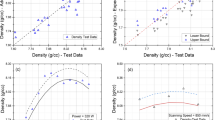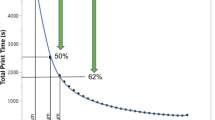Abstract
The building quality of the LPBF (laser powder bed fusion)-fabricated component is critical to determine whether it can be applied in the serving condition. However, it is determined not only by process parameters; the powder property and its affecting factors such as average particle sizes and particle size distribution of powder materials have also significant effect on the building quality. In order to investigate the correlation between the building quality and powder properties, five kinds of powder materials with different average particle sizes and particle size distributions of \({P}_{\mu 20,\sigma 10}\), \({P}_{\mu 35,\sigma 10}\), \({P}_{\mu 50,\sigma 10}\), \({P}_{\mu 35,\sigma 5}\), and \({P}_{\mu 35,\sigma 15}\) are prepared on the basis of the Horsfield filling method. The powder properties such as flowability and apparent density are tested, the build qualities such as dimensional accuracy and surface roughness are measured, and their correlation is analyzed. The results show that the powder material with a narrower particle size distribution benefits flowability. That with medium particle size distribution and average particle size, such as \({P}_{\mu 35,\sigma 10}\), possesses the highest apparent density and acceptable flowability, and the components manufactured with such powder material have the best surface roughness and dimensional accuracy. Besides, an amount of fine particles is required to optimize component density. The above systematic experiments exhibit the correlation among the particle size distribution and the average particle size, powder properties, and build quality, which is beneficial to preparing the powder materials, improving the irradiation conditions of the laser beam, controlling the LPBF process, and further the building quality of LPBF-fabricated component.
















Similar content being viewed by others
Data availability
Data and materials will be available upon request.
References
Annual reports - Fraunhofer IWS. https://www.iws.fraunhofer.de/en/newsandmedia/mediacenter/annual_reports.html. Accessed 5 Dec 2022
Donath S (2019) 3D printing a rocket engine. In: Etmm. https://www.etmm-online.com/3d-printing-a-rocket-engine-a-886960/. Accessed 5 Dec 2022
Chougrani L, Pernot JP, Véron P, Abed S (2019) Parts internal structure definition using non-uniform patterned lattice optimization for mass reduction in additive manufacturing. Eng Comput 35:277–289. https://doi.org/10.1007/s00366-018-0598-2
Murr LE (2020) Metallurgy principles applied to powder bed fusion 3D printing/additive manufacturing of personalized and optimized metal and alloy biomedical implants: an overview. J Mater Res Technol 9:1087–1103. https://doi.org/10.1016/j.jmrt.2019.12.015
Additive GE (2021) New manufacturing milestone: 30,000 additive fuel nozzles. In: GE Addit. https://www.ge.com/additive/stories/new-manufacturing-milestone-30000-additive-fuel-nozzles. Accessed 7 Dec 2022
Wang W, Wang S, Zhang X, Chen F, Xu Y, Tian Y (2021) Process parameter optimization for selective laser melting of Inconel 718 superalloy and the effects of subsequent heat treatment on the microstructural evolution and mechanical properties. J Manuf Process 64:530–543. https://doi.org/10.1016/j.jmapro.2021.02.004
Li S, Lan X, Wang Z, Mei S (2021) Microstructure and mechanical properties of Ti-6.5Al-2Zr-Mo-V alloy processed by laser powder bed fusion and subsequent heat treatments. Addit Manuf 48:102382. https://doi.org/10.1016/j.addma.2021.102382
Sun QD, Sun J, Guo K, Waqar S, Liu JW, Wang LS (2022) Influences of processing parameters and heat treatment on microstructure and mechanical behavior of Ti-6Al-4V fabricated using selective laser melting. Adv Manuf 10:520–540. https://doi.org/10.1007/s40436-022-00389-y
Wu X, Zhang D, Yi D, Hu S, Huang G, Poprawe R, Schleifenbaum JH (2022) Interfacial characterization and reaction mechanism of Ti/Al multi-material structure during laser powder bed fusion process. Mater Charact 192:112195. https://doi.org/10.1016/j.matchar.2022.112195
Riabov D, Leicht A, Ahlström J, Hryha E (2021) Investigation of the strengthening mechanism in 316L stainless steel produced with laser powder bed fusion. Mater Sci Eng A 822:141699. https://doi.org/10.1016/j.msea.2021.141699
Platl J, Leitner H, Turk C, Demir AG, Previtali B, Schnitzer R (2021) Defects in a laser powder bed fused tool steel. Adv Eng Mater 23:2000833. https://doi.org/10.1002/adem.202000833
Jonaet AM, Park HS, Myung LC (2021) Prediction of residual stress and deformation based on the temperature distribution in 3D-printed parts. Int J Adv Manuf Technol 113:2227–2242. https://doi.org/10.1007/s00170-021-06711-5
Nie Y, Tang J, Teng J, Ye X, Yang B, Huang J, Yu S, Li Y (2020) Particle defects and related properties of metallic powders produced by plasma rotating electrode process. Adv Powder Technol 31:2912–2920. https://doi.org/10.1016/j.apt.2020.05.018
Brika SE, Letenneur M, Dion CA, Brailovski V (2020) Influence of particle morphology and size distribution on the powder flowability and laser powder bed fusion manufacturability of Ti-6Al-4V alloy. Addit Manuf 31:100929. https://doi.org/10.1016/j.addma.2019.100929
Yablokova G, Speirs M, Van Humbeeck J, Kruth JP, Schrooten J, Cloots R, Boschini F, Lumay G, Luyten J (2015) Rheological behavior of β-Ti and NiTi powders produced by atomization for SLM production of open porous orthopedic implants. Powder Technol 283:199–209. https://doi.org/10.1016/j.powtec.2015.05.015
Gürtler FJ, Karg M, Dobler M, Kohl S, Tzivilsky I, Schmidt M (2014) Influence of powder distribution on process stability in laser beam melting: analysis of melt pool dynamics by numerical simulations. In: 25th Annual International solid freeform fabrication symposium. An Add Manufac Conf SFF pp 1099–1117
Engeli R, Etter T, Hövel S, Wegener K (2016) Processability of different IN738LC powder batches by selective laser melting. J Mater Process Technol 229:484–491. https://doi.org/10.1016/j.jmatprotec.2015.09.046
Seyda V, Herzog D, Emmelmann C (2017) Relationship between powder characteristics and part properties in laser beam melting of Ti–6Al–4V, and implications on quality. J Laser Appl 29:022311. https://doi.org/10.2351/1.4983240
Pleass C, Jothi S (2018) Influence of powder characteristics and additive manufacturing process parameters on the microstructure and mechanical behaviour of Inconel 625 fabricated by selective laser melting. Addit Manuf 24:419–431. https://doi.org/10.1016/j.addma.2018.09.023
Zhang D, Wang W, Guo Y, Hu S, Dong D, Poprawe R, Schleifenbaum JH, Ziegler S (2019) Numerical simulation in the absorption behavior of Ti6Al4V powder materials to laser energy during SLM. J Mater Process Technol 268:25–36. https://doi.org/10.1016/j.jmatprotec.2019.01.002
Meier C, Weissbach R, Weinberg J, Wall WA, John Hart A (2019) Modeling and characterization of cohesion in fine metal powders with a focus on additive manufacturing process simulations. Powder Technol 343:855–866. https://doi.org/10.1016/j.powtec.2018.11.072
Dadbakhsh S, Verbelen L, Vandeputte T, Strobbe D, Van Puyvelde P, Kruth JP (2016) Effect of powder size and shape on the SLS processability and mechanical properties of a TPU elastomer. Phys Procedia 83:971–980. https://doi.org/10.1016/j.phpro.2016.08.102
Leturia M, Benali M, Lagarde S, Ronga I, Saleh K (2014) Characterization of flow properties of cohesive powders: a comparative study of traditional and new testing methods. Powder Technol 253:406–423. https://doi.org/10.1016/j.powtec.2013.11.045
Jallo LJ, Chen Y, Bowen J, Etzler F, Dave R (2011) Prediction of inter-particle adhesion force from surface energy and surface roughness. J Adhes Sci Technol 25:367–384. https://doi.org/10.1163/016942410X525623
Habibnejad-korayem M, Zhang J, Zou Y (2021) Effect of particle size distribution on the flowability of plasma atomized Ti-6Al-4V powders. Powder Technol 392:536–543. https://doi.org/10.1016/j.powtec.2021.07.026
He Y, Hassanpour A, Bayly AE (2021) Combined effect of particle size and surface cohesiveness on powder spreadability for additive manufacturing. Powder Technol 392:191–203. https://doi.org/10.1016/j.powtec.2021.06.046
Fu J, Li H, Song X, Fu MW (2022) Multi-scale defects in powder-based additively manufactured metals and alloys. J Mater Sci Technol 122:165–199. https://doi.org/10.1016/j.jmst.2022.02.015
Wang F, Del BH, Hyder J, Corliss M, Hung WN (2020) Experimental investigation of porosity distribution in selective laser melted Inconel 718. Procedia Manuf 48:807–813. https://doi.org/10.1016/j.promfg.2020.05.117
Galy C, Le Guen E, Lacoste E, Arvieu C (2018) Main defects observed in aluminum alloy parts produced by SLM: from causes to consequences. Addit Manuf 22:165–175. https://doi.org/10.1016/j.addma.2018.05.005
Zhang D, Feng Z, Wang C, Wang W, Liu Z, Niu W (2018) Comparison of microstructures and mechanical properties of Inconel 718 alloy processed by selective laser melting and casting. Mater Sci Eng A 724:357–367. https://doi.org/10.1016/j.msea.2018.03.073
Calignano F (2018) Investigation of the accuracy and roughness in the laser powder bed fusion process. Virtual Phys Prototyp 13:97–104. https://doi.org/10.1080/17452759.2018.1426368
Khairallah SA, Anderson AT, Rubenchik A, King WE (2016) Laser powder-bed fusion additive manufacturing: physics of complex melt flow and formation mechanisms of pores, spatter, and denudation zones. Acta Mater 108:36–45. https://doi.org/10.1016/j.actamat.2016.02.014
Steuben JC, Iliopoulos AP, Michopoulos JG (2016) Discrete element modeling of particle-based additive manufacturing processes. Comput Methods Appl Mech Eng 305:537–561. https://doi.org/10.1016/j.cma.2016.02.023
DebRoy T, Wei HL, Zuback JS, Mukherjee T, Elmer JW, Milewski JO, Beese AM, Wilson-Heid A, De A, Zhang W (2018) Additive manufacturing of metallic components – process, structure and properties. Prog Mater Sci 92:112–224. https://doi.org/10.1016/j.pmatsci.2017.10.001
Funding
This work is supported by the National Key R&D program of China (Project No. 2018YFE0197100).
Author information
Authors and Affiliations
Contributions
Songtao Hu: conceptualization, methodology, writing—original draft, visualization, investigation, data curation, and formal analysis.
Dongyun Zhang: supervision and writing—review and editing.
Dongdong Dong: methodology, investigation, and formal analysis.
Zhiyuan Liu: data curation.
Hao Huang: formal analysis.
Reinhart Poprawe: conceptualization.
Johannes Henrich Schleifenbaum: conceptualization.
Stephan Ziegler: conceptualization.
Corresponding author
Ethics declarations
Ethical approval
Not applicable.
Consent to participate
Not applicable.
Consent for publication
Not applicable.
Competing interests
The authors declare no competing interests.
Additional information
Publisher's note
Springer Nature remains neutral with regard to jurisdictional claims in published maps and institutional affiliations.
Rights and permissions
Springer Nature or its licensor (e.g. a society or other partner) holds exclusive rights to this article under a publishing agreement with the author(s) or other rightsholder(s); author self-archiving of the accepted manuscript version of this article is solely governed by the terms of such publishing agreement and applicable law.
About this article
Cite this article
Hu, S., Zhang, D., Dong, D. et al. Influence of the properties of Ti6Al4V powder materials on the build quality of laser powder bed fusion–manufactured components. Int J Adv Manuf Technol 129, 969–982 (2023). https://doi.org/10.1007/s00170-023-12244-w
Received:
Accepted:
Published:
Issue Date:
DOI: https://doi.org/10.1007/s00170-023-12244-w




